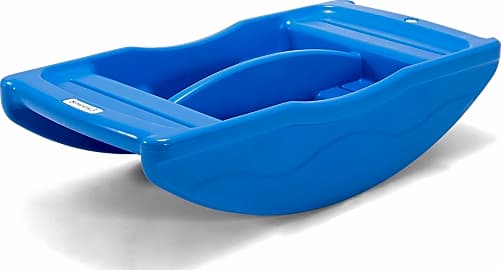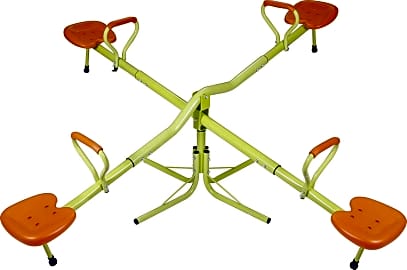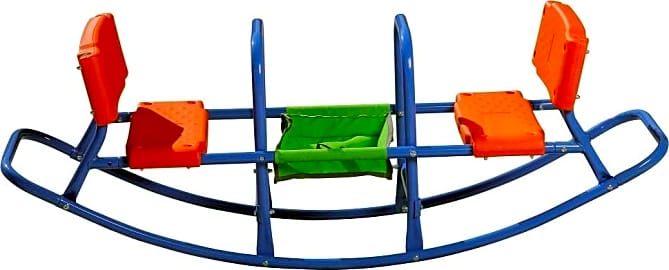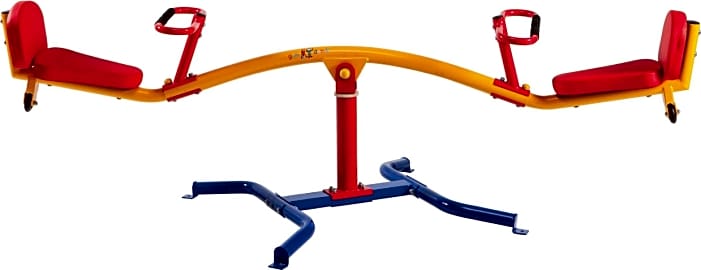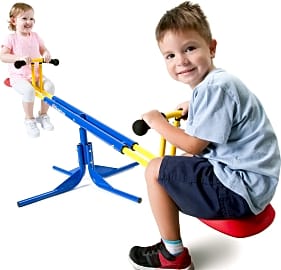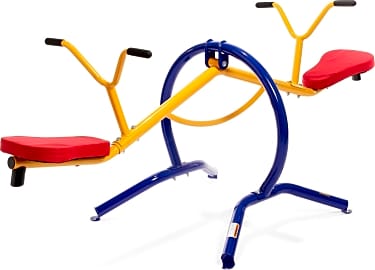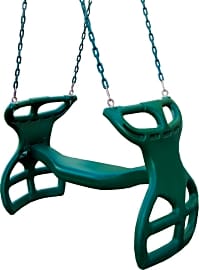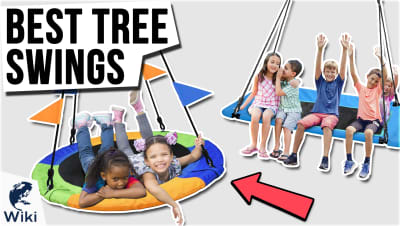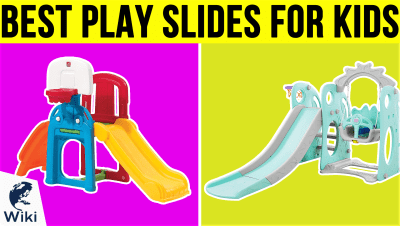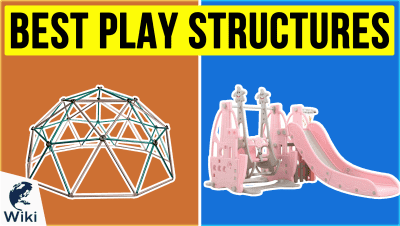The 8 Best Teeter Totters

This wiki has been updated 40 times since it was first published in June of 2015. Your kids will be entertained for hours on end with any one of these fine teeter totters. Many are designed for indoor or outdoor use, and can provide youngsters with plenty of imaginative fun while they also get some exercise and develop important motor skills, like balance and coordination. Be sure to keep children safe by supervising them whenever they're using these seesaws. When users buy our independently chosen editorial selections, we may earn commissions to help fund the Wiki.
Editor's Notes
April 20, 2021:
We removed a number of selections in this update due to availability issues. In replacing them, we considered several factors including durability, safety, and variety. Note that several of these toys are only meant for toddler-age kids, so pay close attention to the size and weight capacity of each before you buy.
New to the list, the Simplay3 Rock and Roll is a versatile choice that can turn into a bridge with three textured steps when flipped over. The bridge side can encourage fitness for little ones and would fit in nicely with a home obstacle course. The seesaw side resembles a little boat, so it's a good choice for toddlers who are going through a pirate phase.
We added the Nova Playground because it's a full-size model that can accommodate four kids at once. However, it works just as well with two kids, so you don't need to fill it every time. It features bump absorbers that reduce the impact of hitting the ground and prevent the seats from slamming into your children's feet.
If you have a kid who has balance issues and you worry that they might fall off a traditional model, they can probably handle the SlideWhizzer Rocking. It has wide seats and stays low to the ground. Plus its rocking motion is gentler and impact-free.
The Eastern Jungle Gym Swing is not, strictly speaking, a teeter totter, but we thought that the up & down, back & forth motion it provides made it fair game for the list. And if you already have a jungle gym taking up space in your backyard, it might be a better choice than a new piece of standalone equipment.
We also added the Grow'n Up Heracles, which has a fairly simple design with a few notable features like molded seats and soft foam handles. One thing it lacks, however, is a bump absorber. This means that it's possible for the seat to hit the ground directly, and that feet can get smashed or caught underneath. However if you think your children can learn to simply keep their feet out of the way and be careful while playing, this sturdy and affordable model might be a good choice for you.
March 19, 2020:
Like tree swings and play slides, teeter totters have provided little ones with loads of fun for many generations. The colorful, modern designs on our list are safe and sturdy, and many conveniently require little to no assembly. The newly added TP Toys Spiro Spin lets kids rotate as they go up and down, for double the fun. It features foam pads that help protect your floors, and its hollow base allows you to fill it with sand for added stability. It’s got inflatable rubber wheels and an adjustable balance point to accommodate riders of different heights.
We also added in the Pure Fun 360 Swivel, and what makes this model stand out is an attachable phonetic counter that recites numbers and letters as kids go up and down, which adds a learning element to the fun. It’s also made with safety in mind, featuring soft padded grips and heavy-duty steel tubing. The manufacturer provides a helpful step-by-step assembly video online.
Today we added in the Little Tikes Alligator, a cool green rocker with bright eyes that can accommodate up to three kids at a time. It runs five feet in length and features sturdy red handles. Like the Little Tikes Whale, this one requires absolutely no assembly, cleans easily with soap and water, and is made in the USA.
Leaving the list today are the Skywalker Sports Swivel, which many find difficult to assemble, as well as the Step2 Play Up, which is unavailable at this time. Practice seesaw safety by teaching kids to keep their hands wrapped around the handlebars during use (and feet planted on the footrests, if provided), and always supervise them during use.
Special Honors
Sycamore Creek Creations Teeter Totter Customize your seesaw with a model that’s made from parts of antique wheel, steel tubing, pipe handles, and tractor seats. You can choose a size that’s right for your family, and any colors you wish. You also have the option to paint yours yourself. They’re made for the long haul and can provide many years’ worth of use when cared for properly. They're crafted at a shop in the Texas hill country, where custom furniture, planters, yard art, and more are created. sycamorecreekcreations.com
We-saw A new take on the traditional seesaw, this unique piece of playground equipment provides a gentle rocking motion that’s suitable for kids of all ages and abilities. It’s wheelchair accessible and includes four seats with a center platform for additional participants. The platform and seats are made of marine-grade, high-density polyethylene. It incorporates a spring mechanism and in-ground bumpers that protect from impact. Rubber components on the hand- and foot-holds provide a firm grip. It’s made in the U.S.A. by a company that plants trees to offset the carbon produced as a result of its manufacturing. playlsi.com
Developmental Benefits Of Teeter Totters
Teeter totters are more than just fun; they are beneficial to children, as well.
Teeter totters are more than just fun; they are beneficial to children, as well. It may not seem like it at first glance, but successfully operating a teeter totter requires a number of physical and mental abilities. One of the core components of playing on a teeter totter is social interaction. Unlike some other playground activities, such as using a slide or climbing wall, teeter totters require the involvement of two children. This can help a child to become more socially adept. Unless they have arrived at a playground with a sibling or friend, they will have to approach another child in the playground to find a teeter totter partner. Learning how to make friends is a valuable skill that can benefit someone throughout their entire life. Having the confidence to approach a new person and initiate a conversation can often mean the difference between someone having a healthy social life as they age or spending the majority of their time alone.
Once on the teeter totter, the two children must cooperate to make it rock back and forth. In order to coordinate their movements, children have to focus on their timing. If a child doesn't sequence their movements correctly, they will not be able to move the teeter totter's center of mass to the correct point to raise the other child into the air, and vice versa. Sequencing skills are very important, as they play a major role in successfully performing a range of daily activities, from writing to assembling toys and playing sports.
Playing on a teeter totter also helps a child develop better balance. Rocking up and down stimulates the vestibular system, which is responsible for balance and spatial orientation. Humans have a vestibular apparatus inside of the ear that detects vertical orientation, as well as linear and rotational movement, and sends this information to the brain. The more the vestibular apparatus is stimulated, the better a child's body learns how to process the information sent from these receptors and the better it learns how to balance itself in different conditions.
Jumping up and down on a teeter totter helps develop muscle strength, as well. A number of muscle groups activate as a child performs the different actions. Muscles in the hands and arms are used to grip the handle, leg muscles are used to jump off the ground and cushion the landing, and core muscles are activated as the child leans forwards and backwards to change their center of mass.
The Many Names Of The Teeter Totter
The teeter totter has been a staple in playgrounds for as long as anyone can remember. Over time, different regions have developed their own names for this beloved toy. The two most common names are seesaw and teeter totter. Some believe the name seesaw is an Anglicisation of the French words ci and ça, which literally translate to "this" and "that". This seems to aptly describe the simple back and forth motion of the seesaw, so it is certainly a possibility.
The teeter totter has been a staple in playgrounds for as long as anyone can remember.
Others believe the term seesaw stems from a combination of the French word scie and the Anglo-Saxon word saw. Scie directly translates to saw in English, so it is actually the repetition of the same exact word, just in two different languages. It can be said that the up and down motion of a seesaw is akin to the back and forth motion of a saw, also making this a possibility, as well.
Teeter totter is most likely an adaptation of the Nordic word tittermatorter, which is what this playground toy is called in the Scandinavian region. This term likely came about due to the feeling a teeter totter creates of teetering on the edge of going up and going down. Doubling a word or syllable with a different vowel or consonant is known as reduplication and it is actually a common linguistic process. Some other examples of reduplication are zig-zag, criss-cross, hanly-panky, hodge-podge, and flip-flop.
While seesaw and teeter totter may be the most popular names throughout much of the United States, this doesn't mean they are the only names. Depending on what region you happen to be in, people may call it a tilt, tilting board, teedle board, ridey horse, or hickey horse.
The Physics Behind The Teeter Totter
A teeter tooter is essentially just a lever. By utilizing a long rigid board and a fulcrum, it allows the users to lift a lot of weight with less effort than would normally be required. It works on the basic law of physics that states work is equal to force applied over a distance.
Now, if you have two children of unequal weight, you can still obtain an equilibrium if the heavier child sits closer to the fulcrum.
The fulcrum of a teeter totter is placed at the exact center of the two seats. This means that for the teeter totter to sit exactly level, the turning force on both sides must be identical, with one force moving clockwise and the other force moving counterclockwise. If you were to place two children of equal weight on opposing ends of the teeter totter, it would sit level as long as neither one of them performed an action that affected this equilibrium. Now, if you have two children of unequal weight, you can still obtain an equilibrium if the heavier child sits closer to the fulcrum. This is because the closer you are to the fulcrum, the more weight that is required to reach the moment of force, or the point at which the lever reaches the turning point.
As children lean forwards and backwards on a teeter totter, they are moving their center of mass. This brings the force closer and further from the fulcrum. So two children of roughly equal weight can sit an equal distance from the fulcrum, and just move their center of mass back and forth to make the teeter totter move up and down. Two children of unequal weight can still use a teeter totter together in the same manner as long as the heavier child sits closer to the fulcrum.


